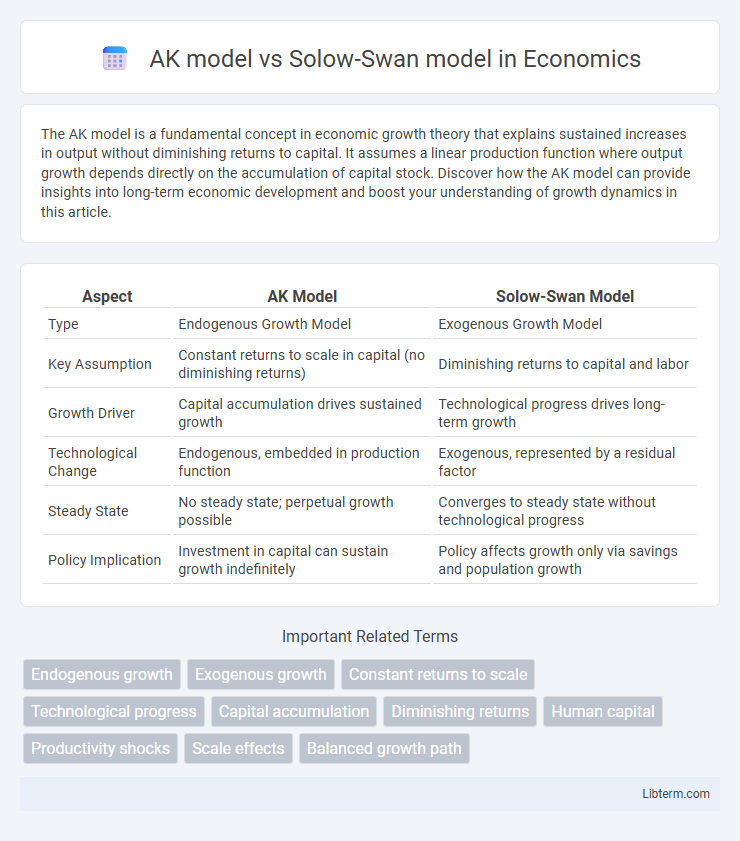The AK model is a fundamental concept in economic growth theory that explains sustained increases in output without diminishing returns to capital. It assumes a linear production function where output growth depends directly on the accumulation of capital stock. Discover how the AK model can provide insights into long-term economic development and boost your understanding of growth dynamics in this article.
Table of Comparison
| Aspect | AK Model | Solow-Swan Model |
|---|---|---|
| Type | Endogenous Growth Model | Exogenous Growth Model |
| Key Assumption | Constant returns to scale in capital (no diminishing returns) | Diminishing returns to capital and labor |
| Growth Driver | Capital accumulation drives sustained growth | Technological progress drives long-term growth |
| Technological Change | Endogenous, embedded in production function | Exogenous, represented by a residual factor |
| Steady State | No steady state; perpetual growth possible | Converges to steady state without technological progress |
| Policy Implication | Investment in capital can sustain growth indefinitely | Policy affects growth only via savings and population growth |
Introduction to Economic Growth Models
The AK model emphasizes endogenous growth driven by constant returns to capital without diminishing returns, contrasting with the Solow-Swan model's assumption of diminishing returns and exogenous technological progress. In the Solow-Swan framework, long-term growth depends on technological advancement outside the model, while the AK model integrates knowledge accumulation as a key driver of sustained growth. These fundamental differences highlight the AK model's ability to explain persistent growth through capital accumulation alone, unlike the Solow-Swan model's convergence to a steady-state growth path.
Overview of the AK Model
The AK model represents endogenous growth theory, where output growth depends linearly on accumulated capital without diminishing returns, contrasting the Solow-Swan model's assumption of diminishing returns to capital. Capital accumulation in the AK model drives sustained long-term growth, as the production function is expressed as Y = AK, with A as a positive technology parameter. This framework eliminates the need for exogenous technological progress, making it crucial for explaining persistent economic growth through investment rates and capital stock alone.
Overview of the Solow-Swan Model
The Solow-Swan model explains long-term economic growth based on capital accumulation, labor or population growth, and technological progress, highlighting diminishing returns to capital. It predicts that economies converge to a steady-state growth path where output per worker grows only through technological improvements. Unlike the AK model, which assumes constant returns to capital and endogenous growth, the Solow-Swan framework relies on exogenous technological change to sustain growth.
Key Assumptions of the AK and Solow-Swan Models
The AK model assumes constant returns to scale in capital and endogenous technological progress, implying that investment directly drives perpetual economic growth without diminishing returns. The Solow-Swan model relies on diminishing returns to capital and exogenous technological progress, highlighting that long-term growth depends on technological advances rather than capital accumulation alone. Key distinctions include the AK model's linear production function versus the Solow-Swan model's Cobb-Douglas function with diminishing marginal productivity of capital.
Capital Accumulation: AK vs Solow-Swan
The AK model features a linear production function where output is directly proportional to capital, eliminating diminishing returns and enabling sustained endogenous growth through continuous capital accumulation. In contrast, the Solow-Swan model incorporates diminishing returns to capital, leading to a steady-state equilibrium where capital accumulation slows economic growth absent technological progress. Consequently, the AK model predicts persistent growth driven by capital accumulation alone, while the Solow-Swan model requires exogenous technological advancement to sustain long-term growth.
Role of Technological Progress
The Solow-Swan model treats technological progress as an exogenous factor driving long-term economic growth, assuming it improves productivity independently of capital accumulation. In contrast, the AK model incorporates technological progress endogenously, linking it directly with capital accumulation and investment to sustain constant returns to scale. This endogenous approach explains persistent growth without relying on external technological improvements, highlighting the critical role of innovation and knowledge spillovers within the capital formation process.
Presence or Absence of Diminishing Returns
The AK model assumes constant returns to capital, eliminating diminishing returns and enabling perpetual growth through capital accumulation alone. In contrast, the Solow-Swan model incorporates diminishing returns to capital, causing long-term growth to depend on exogenous technological progress rather than capital accumulation. This fundamental difference influences their predictions on sustainable economic growth and policy implications for investment and technology.
Steady-State Implications and Long-Term Growth
The AK model predicts endogenous long-term economic growth driven by constant returns to capital, eliminating the steady-state growth constraints found in the Solow-Swan model. In contrast, the Solow-Swan model emphasizes exogenous technological progress as the sole determinant of sustained per capita growth, with capital accumulation facing diminishing returns and leading to a steady-state equilibrium. This fundamental difference highlights the AK model's ability to generate persistent growth without relying on external technological advances, challenging traditional views on steady-state limitations.
Policy Implications: AK vs Solow-Swan
The AK model suggests that policy measures promoting capital accumulation -- such as investment tax credits and reduced capital taxes -- can sustain endogenous economic growth without diminishing returns. In contrast, the Solow-Swan model implies that long-term growth depends primarily on exogenous technological progress, meaning policies should focus on innovation, research and development, and human capital enhancement. Policymakers relying on the Solow-Swan framework prioritize improving productivity through technological advancement rather than capital deepening alone.
Empirical Evidence and Real-World Applications
Empirical evidence suggests the AK model better captures sustained endogenous growth patterns by emphasizing technology and human capital accumulation, especially in economies with continuous innovation. The Solow-Swan model effectively explains convergence in per capita income among countries with similar savings rates and population growth but struggles to account for persistent growth without exogenous technological progress. Real-world applications of the AK model include policy designs promoting innovation and education, while the Solow-Swan framework remains instrumental in assessing the impact of capital accumulation and productivity improvements on economic development.
AK model Infographic

 libterm.com
libterm.com